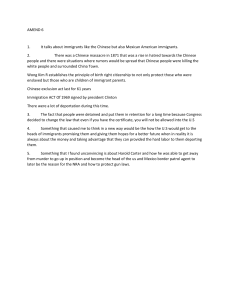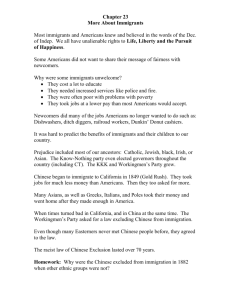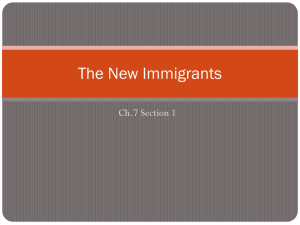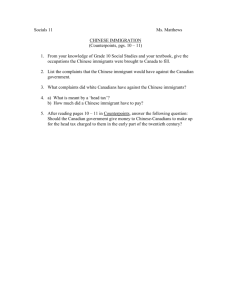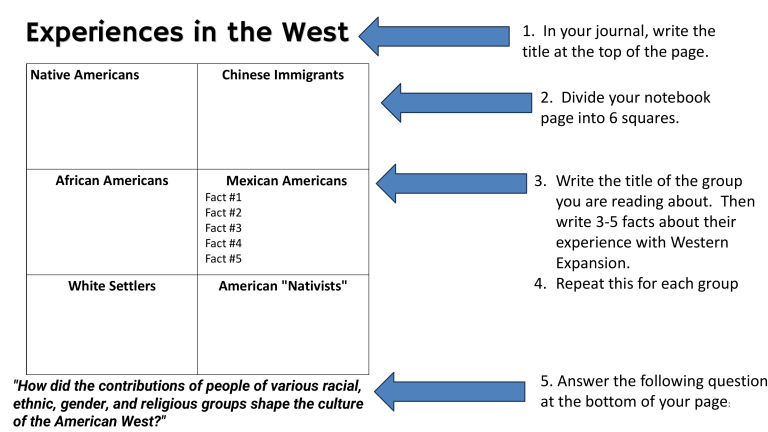
Experiences in the West Native Americans 1. In your journal, write the title at the top of the page. Chinese Immigrants 2. Divide your notebook page into 6 squares. African Americans Mexican Americans Fact #1 Fact #2 Fact #3 Fact #4 Fact #5 White Settlers American "Nativists" "How did the contributions of people of various racial, ethnic, gender, and religious groups shape the culture of the American West?" 3. Write the title of the group you are reading about. Then write 3-5 facts about their experience with Western Expansion. 4. Repeat this for each group 5. Answer the following question at the bottom of your page: Experiences in the West In looking at the history of the American West, it is important to keep in mind the myths that arose around the settling of the West in the second half of the nineteenth century. The influential historian Frederick Jackson Turner described a uniquely American personality forged by the experience of taming the wilderness and critical to the success and growth of the United States. That view of the West as a frontier where heroic white settlers and cowboys struggled to bring civilization to a savage land framed popular and scholarly thinking for years to come. More recently, however, historians have questioned the notion of the frontier. Instead, they have argued that the nineteenth-century West was a crossroads of cultures. Native Americans Approximately 75,000 Native Americans inhabited the Great Plains in the mid-1800s. The Plains Indians economic well-being as well as their culture depended on the buffalo. Buffalo were a vital source as they provided necessary supplies such as food, shelter, and tools. With the construction of the Transcontinental Railroad, not only was much of the buffalo’s natural habitat destroyed, but they were hunted from the trains for sport. Indian Wars Native Americans did not want to abandon their homelands to settle on federal land. But when more gold was discovered in 1874 in the Black Hills, the U.S. government demanded that the Sioux move away from the Hills. The leader of the Sioux tribe, Crazy Horse, was not pleased with this demand. He killed over 80 cavalry troops in 1866 in response for forts being built on his tribe's hunting ground. In the Battle of Little Bighorn, Lieutenant Colonel George Armstrong Custer attacked a Sioux camp in Montana. The Sioux tribe was able to defeat the U.S. Army after surrounding them. It was a major victory for Native Americans. The “Indian Wars” came to an end in December of 1890 with the Battle at Wounded Knee. In response to the Sioux performing a banned ceremony called the “Ghost Dance,” a battle between US soldiers and tribe members took place. While 25 soldiers died, approximately 200 Natives were slaughtered. The Ghost Dance was a ceremony incorporated into numerous Native American belief systems. According to the teachings, proper practice of the dance would reunite the living with spirits of the dead, bring the spirits to fight on their behalf, end American Westward expansion, and bring peace, prosperity, and unity to Native American peoples throughout the region. IMAGE: The Ghost Dance of 1889–1891 by the Oglala Lakota at Pine Ridge. Illustration by western artist Frederic Remington, 1890. American reformers believed that Native Americans should adopt "white" ways and become assimilated into American culture. The Dawes Act, passed in 1887, tried to make Indians adopt new ways instead of following tradition. American Indian land was no longer shared and instead was divided into individual family lots. The results were that land was lost and Native Americans suffered from poor living conditions. In addition, the Bureau of Indian Affairs sponsored the creation of Indian boarding schools, the most well-known being the Carlisle Indian Industrial School in Pennsylvania. These schools were separated from reservations with the hope of Americanizing the native children by, among other things requiring them to speak English and choose English names. Chinese Immigrants Most Chinese immigrants came to the U.S. to escape poverty, famine, lack of jobs, etc. Chinese immigrants were processed through Angel Island, which is in San Franciso Bay in California. Chinese immigrants were not allowed to become US citizens by law, and often faced discrimination and violence from American settlers. The Chinese community banded together to create social and cultural centers in cities (known as Chinatown). A Chinatown served as a safe haven and second home for Chinese immigrants, a place to shop for familiar food, to worship in a traditional temple, or to catch up on the news from the old country. Chinese Americans were considered cheap labor. They easily found employment as farmhands, gardeners, domestics, laundry workers, and most famously, railroad workers. By the 1870s, there was widespread economic depression in America and jobs became scarce. Hostility had been growing toward the Chinese American workers. The new California constitution of 1879 denied naturalized Chinese citizens the right to vote or hold state employment. Additionally, in 1882, the US Congress passed the Chinese Exclusion Act, which was the first significant law restricting immigration into the U.S. It restricted immigration from China for ten years. The ban was later extended on multiple occasions until its repeal in 1943. Image below: Exodusters of Nicodemus, KS ca. 1877 African Americans Shortly after the war, freed African Americans were able to purchase land, organize schools, and participate in civic life. These freedoms were shortlived as organizations such as the Ku Klux Klan and The White League of Louisiana began campaigns of violence and other acts of intimidation to prevent people from voting and settling where they wished. Following the end of the Civil War the following 3 amendments were passed to expand the rights of former enslaved peoples: •13th Amendment- No slavery •14th Amendment- Grants citizenship •15th Amendment- Male Suffrage (right to vote) Despite the addition of those amendments, thousands of Black people chose to leave the South in the hope of finding equality on the frontier. Taking their cue from the Book of Exodus in the Old Testament, they called themselves “Exodusters.” The majority of Exodusters settled in Kansas, but many settled in what would become Oklahoma, Colorado, Ohio, Nebraska, North Dakota, South Dakota, New Mexico, Arizona, and Montana. More than 6,000 Exodusters had arrived in Kansas in the spring of 1879 alone. In this year, Kansas Governor John P. St. John created The Freedmen’s Relief Association of Kansas to assist with settling the new citizens. This organization built schools and permanent as well as transitional housing for the new arrivals. It is estimated that in the 1870s, approximately 40,000 to 60,000 African Americans left the South and migrated westward. By the end of the migration in 1880, Kansas alone was home to approximately 41,000 African Americans. On June 7, 1892, Homer Plessy sat in a railroad car that was only for white people. He did this on purpose and identified himself as being an African American. Because of the Separate Car Act, his action was illegal, and he was arrested. His state trial was held in New Orleans, where the judge ruled that the Separate Car Act should be followed. This court case was appealed, and it went all the way to the Supreme Court. Plessy v. Ferguson (1896), was a landmark U.S. Supreme Court decision ruling that racial segregation laws did not violate the U.S. Constitution as long as the facilities for each race were equal in quality, a doctrine that came to be known as "separate but equal". These laws enforced racial segregation. The Plessy v. Ferguson decision upheld the principle of racial segregation for over 50 years. The story of Mexican Americans is inextricably linked to the fortunes of the United States itself. Before 1854 a large part of the western U.S., including much of Arizona, California, Colorado, Nevada, New Mexico, Texas, Utah and Wyoming was part of Mexico. Though war, treaties and land purchases roughly 100,000 Mexicans came under the jurisdiction of the U.S. In what had been their own land, these new American citizens faced racial discrimination including loss of property, low wages and even lynching. By 1890, the need for cheap labor had drawn another 75,000 Mexicans to the U.S. Much like Chinese immigrants, Mexican American citizens were relegated to the worst-paying jobs under the worst working conditions. They worked as peóns (manual laborers similar to slaves), vaqueros (cattle herders), and cartmen, transporting food and supplies, on the cattle ranches that white landowners possessed, or they undertook the most hazardous mining tasks. Mexican Americans Despite promises made to Mexican Americans after the Mexican Cession, many lost their land to white settlers. They turned inward to their own neighborhoods, or barrios, for support and cultural continuity. Mexican Americans were often given the worst paying jobs under poor working conditions. Laws passed in communities to deprive Mexican their heritage. "Sunday Laws" prohibited “noisy amusements” such as bullfights, cockfights, and other cultural gatherings common to Mexican American communities at the time. Mexican Americans were often segregated from whites which was legally allowed with the Plessy v Ferguson ruling. White Settlers Settlers had to learn how to farm on the Great Plains. The soil was held together by grass roots and was called sod. Settlers were called sodbusters because they had to break through the sod to plant crops. There was not a lot of wood, so settlers used sod to build homes called "soddies". Winters were long and cold whereas summers were hot and dry with many droughts. There were grass fires because it was so dry. Farmers had to grow crops that did not need much water. They either carried water from streams or used windmills to pump water from underground. New machines, such as harvesters and threshers, made it easier to grow more crops with less people. The homesteaders faced many challenges. Everything about the prairie was extreme. The land was flat and treeless, and the sky seemed to go on forever. On a tall-grass prairie, the grass sometimes grew to be more than 6 feet tall. It is said that riders on horseback could pick wildflowers without dismounting. Women worried about their children getting hopelessly lost in the grass. Summer brought endless days of heat when the surface temperature could exceed 120 degrees. Periods of drought, rainstorms, tornadoes, swarms of grasshoppers that could destroy fields of crops, and never-ending wind also challenged settlers. Winters were long and cold. Blizzards were so strong that they could trap livestock and homesteaders under the snow. During the long winter of 1886, horses and cattle died when their breaths froze over the ends of their noses, making it impossible for them to breathe. Building a home and establishing a farm was a challenge for even the most experienced farmers, but the free land, abundant wildlife, and richness of the soil made the challenge hard to resist. Nativist Nativist refers to people who are “born” or “native” to the U.S. and want to restrict immigration. They believe that people of other races, religions, and nationalities are inferior to white, Anglo-Saxon, Protestant Americans. In the late nineteenth century (1800s) and early twentieth century (1900s), nativism spread as immigration to the United States reached new heights. Italians and Eastern Europeans fleeing poverty and religious persecution became the “new” immigrants as Irish and Germans became “white.” Congress enacted laws banning Chinese and Japanese immigrants altogether during this period, and eventually passed sweeping measures limiting the stream of immigrants to a trickle. Fear of the “other” has remained a potent force in American society ever since.
